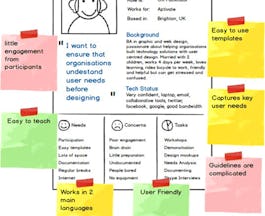Filter by
The language used throughout the course, in both instruction and assessments.
Explore the Charting Course Catalog


University of Pennsylvania
Skills you'll gain: Data Storytelling, Data Presentation, Data Visualization Software, Tableau Software, Presentations, Interactive Data Visualization, Verbal Communication Skills, Statistical Visualization, Storytelling, Persuasive Communication, Chart.js, Data Analysis, Pivot Tables And Charts, Scatter Plots, Stakeholder Communications, Spatial Analysis, Trend Analysis, Forecasting


Università di Napoli Federico II
Skills you'll gain: Market Liquidity, Securities Trading, Financial Trading, Financial Market, Market Dynamics, Market Trend, Market Data, Technical Analysis, Price Negotiation, Financial Regulation, Order Processing, Algorithms


Coursera Project Network
Skills you'll gain: User Story, Backlogs, Product Roadmaps, Sprint Planning, Agile Product Development, User Research, Product Planning, Agile Methodology, Prioritization


Universidad de los Andes
Skills you'll gain: Technical Analysis, Financial Trading, Financial Market, Performance Measurement, Capital Markets, Market Trend, Investments, Market Data, Return On Investment, Statistical Machine Learning, Financial Analysis, Machine Learning, Classification And Regression Tree (CART), Trend Analysis


Johns Hopkins University
Skills you'll gain: Data Visualization, Data Visualization Software, Interactive Data Visualization, Geospatial Information and Technology, Color Theory, Tree Maps, Data Storytelling, Tableau Software, Data Mapping, Text Mining, Unstructured Data, Network Analysis, Graph Theory


Johns Hopkins University
Skills you'll gain: Scientific Visualization, Data Visualization Software, Visualization (Computer Graphics), Interactive Data Visualization, Computer Displays, Time Series Analysis and Forecasting, Scalability, Verification And Validation, Computer Graphics, 3D Modeling

Skills you'll gain: Matplotlib, Data Visualization, Statistical Visualization, Data Visualization Software, Interactive Data Visualization, Scatter Plots, Jupyter, Histogram, Box Plots, Graphing

Skills you'll gain: Plot (Graphics), Data Visualization Software, Ggplot2, Statistical Visualization, R Programming, Scatter Plots, Regression Analysis, Data Manipulation, Statistical Programming, Statistical Analysis, Data Analysis, Data Import/Export, Exploratory Data Analysis, Development Environment, Data Structures


University of Colorado Boulder
Skills you'll gain: Matplotlib, Plotly, Seaborn, Data Visualization Software, Statistical Visualization, Interactive Data Visualization, Data Presentation, Data Storytelling, Scatter Plots, Box Plots, Heat Maps, Histogram, Data Analysis

Skills you'll gain: Blockchain, Web Development Tools, Security Software, Software Development Tools, Emerging Technologies, Cryptography, Digital Assets, Payment Systems, Investments, Web Development, Investment Management, FinTech, Web Applications, Technology Strategies, Technical Analysis, Encryption, Javascript and jQuery, Software Development, Other Programming Languages, Javascript


Corporate Finance Institute
Skills you'll gain: Star Schema, Data Modeling, Tableau Software, Interactive Data Visualization, Business Intelligence, Extract, Transform, Load, Dashboard, Performance Tuning, Technical Analysis, Database Design, Data Visualization Software, Data Manipulation, Market Data, Investment Banking, Exploratory Data Analysis, Tree Maps, Financial Trading, Data Integration, Key Performance Indicators (KPIs), Trend Analysis


Interactive Brokers
Skills you'll gain: Growth Strategies, Business Valuation, Investments, Profit and Loss (P&L) Management, Competitive Analysis, Financial Statement Analysis, Financial Analysis, Business Metrics, Strategic Thinking, Market Trend, Market Dynamics, Financial Forecasting, Risk Analysis, Business Risk Management
In summary, here are 10 of our most popular charting courses
- Data Viz Using Tableau & Presenting With Storytelling: University of Pennsylvania
- Market Microstructure: Università di Napoli Federico II
- Create User Stories in Miro: Coursera Project Network
- Algoritmos de negociación basados en machine learning: Universidad de los Andes
- Advanced Techniques in Data Visualization: Johns Hopkins University
- Specialized Data Visualization Approaches: Johns Hopkins University
- Visualizing Data & Communicating Results in Python: Codio
- How to Visualize Data with R: Packt
- BiteSize Python: Data Visualization: University of Colorado Boulder
- Complete Cryptocurrency & Blockchain Course | Learn Solidity: Packt











